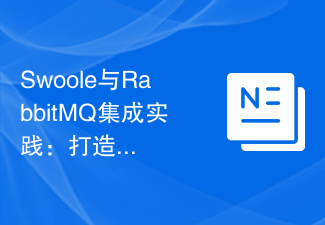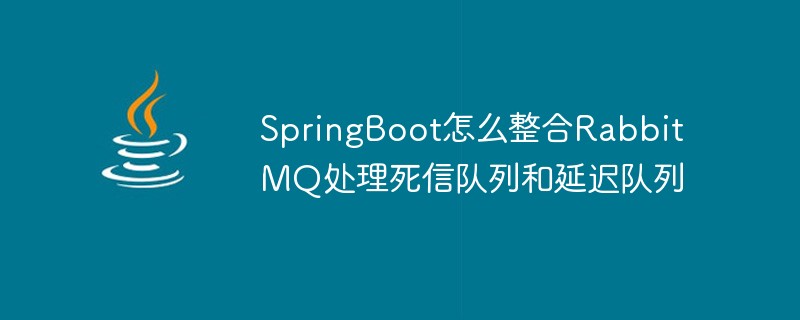
RabbitMQ is an open source implementation of AMQP (Advanced Message Queuing Protocol) developed by erlang.
AMQP: Advanced Message Queuing Protocol is an open standard for application layer protocols, designed for message-oriented middleware. Message middleware is mainly used for decoupling between components. The sender of the message does not need to know the existence of the message consumer, and vice versa. The main features of AMQP are message-oriented, queue-oriented, routing (including point-to-point and publish/subscribe), reliability, and security. RabbitMQ is an open source AMQP implementation. The server is written in Erlang language and supports a variety of clients, such as: Python, Ruby, .NET, Java, JMS, C, PHP, ActionScript, XMPP, STOMP, etc., and supports AJAX. It is used to store and forward messages in distributed systems, and performs well in terms of ease of use, scalability, and high availability.
1. Application Scenario
- Asynchronous Processing
- Application Decoupling
- Traffic Peak Shaving
2. RabbitMQ features
RabbitMQ originally originated from the financial system and is used to store and forward messages in distributed systems. It performs well in terms of ease of use, scalability, and high availability. Specific features include:
- 可靠性(Reliability) RabbitMQ 使用一些机制来保证可靠性,如持久化、传输确认、发布确认。 - 灵活的路由(Flexible Routing) 在消息进入队列之前,通过 Exchange 来路由消息的。对于典型的路由功能,RabbitMQ 已经提供了一些内置的 Exchange 来实现。针对更复杂的路由功能,可以将多个 Exchange 绑定在一起,也通过插件机制实现自己的 Exchange 。 - 消息集群(Clustering) 多个 RabbitMQ 服务器可以组成一个集群,形成一个逻辑 Broker 。 - 高可用(Highly Available Queues) 队列可以在集群中的机器上进行镜像,使得在部分节点出问题的情况下队列仍然可用。 - 多种协议(Multi-protocol) RabbitMQ 支持多种消息队列协议,比如 STOMP、MQTT 等等。 - 多语言客户端(Many Clients) RabbitMQ 几乎支持所有常用语言,比如 Java、.NET、Ruby 等等。 - 管理界面(Management UI) RabbitMQ 提供了一个易用的用户界面,使得用户可以监控和管理消息 Broker 的许多方面。 - 跟踪机制(Tracing) 如果消息异常,RabbitMQ 提供了消息跟踪机制,使用者可以找出发生了什么。 - 插件机制(Plugin System) RabbitMQ 提供了许多插件,来从多方面进行扩展,也可以编写自己的插件。
3. Basic concepts of RabbitMQ
- Message 消息,消息是不具名的,它由消息头和消息体组成。消息体是不透明的,而消息头则由一系列的可选属性组成,这些属性包括routing-key(路由键)、priority(相对于其他消息的优先权)、delivery-mode(指出该消息可能需要持久性存储)等。 - Publisher 消息的生产者,也是一个向交换器发布消息的客户端应用程序。 - Exchange 交换器,用来接收生产者发送的消息并将这些消息路由给服务器中的队列。 - Routing Key 路由关键字,exchange根据这个关键字进行消息投递。 - Binding 绑定,用于消息队列和交换器之间的关联。一个绑定就是基于路由键将交换器和消息队列连接起来的路由规则,所以可以将交换器理解成一个由绑定构成的路由表。 - Queue 消息队列,用来保存消息直到发送给消费者。它是消息的容器,也是消息的终点。一个消息可投入一个或多个队列。消息一直在队列里面,等待消费者连接到这个队列将其取走。 - Connection 网络连接,比如一个TCP连接。 - Channel 信道,多路复用连接中的一条独立的双向数据流通道。信道是建立在真实的TCP连接内地虚拟连接,AMQP 命令都是通过信道发出去的,不管是发布消息、订阅队列还是接收消息,这些动作都是通过信道完成。因为对于操作系统来说建立和销毁 TCP 都是非常昂贵的开销,所以引入了信道的概念,以复用一条 TCP 连接。 - Consumer 消息的消费者,表示一个从消息队列中取得消息的客户端应用程序。 - Virtual Host 虚拟主机,表示一批交换器、消息队列和相关对象。虚拟主机是共享相同的身份认证和加密环境的独立服务器域。每个 vhost 本质上就是一个 mini 版的 RabbitMQ 服务器,拥有自己的队列、交换器、绑定和权限机制。vhost 是 AMQP 概念的基础,必须在连接时指定,RabbitMQ 默认的 vhost 是 / 。 - Broker 表示消息队列服务器实体。它提供一种传输服务,它的角色就是维护一条从生产者到消费者的路线,保证数据能按照指定的方式进行传输,
4. Exchange type
Exchange has different distribution strategies based on different types when distributing messages. There are currently four types. Type: direct, fanout, topic, headers. headers matches the header of the AMQP message instead of the routing key. In addition, the headers switch is exactly the same as the direct switch, but the performance is much worse. It is almost unused now, so look directly at the other three types:
- direct
If the routing key in the message is consistent with the binding key in Binding, the exchanger will send the message to the corresponding queue. The routing key exactly matches the queue name. If a queue is bound to the switch and requires the routing key to be "dog", only the messages marked with the routing key "dog" will be forwarded. "dog.puppy" will not be forwarded, nor will "dog.puppy" or "dog.puppy" be forwarded. dog.guard" and so on. It is an exact match, unicast mode.
- fanout
Every message sent to a fanout type exchanger will be distributed to all bound queues. The fanout exchange does not handle routing keys, but simply binds queues to the exchange. Each message sent to the exchange will be forwarded to all queues bound to the exchange. Much like a subnet broadcast, each host in the subnet gets a copy of the message. The fanout type is the fastest to forward messages.
- topic
topic The exchange assigns the routing key attribute of the message through pattern matching and matches the routing key with a certain pattern. At this time, the queue needs to be bound to a On the model. It splits strings of routing keys and binding keys into words separated by dots. It also recognizes two wildcard characters: the symbol "#" and the symbol "". #Match 0 or more words, no more than one word.
5. ConnectionFactory, Connection, Channel
ConnectionFactory, Connection, and Channel are the most basic objects in the API provided by RabbitMQ.
- Connection is the socket link of RabbitMQ, which encapsulates some logic related to the socket protocol.
- ConnectionFactory is the manufacturing factory of Connection.
- Channel is the most important interface for us to deal with RabbitMQ. Most of our business operations are completed in the Channel interface, including defining Queue, defining Exchange, binding Queue and Exchange, publishing messages, etc. .
6. Task distribution mechanism
1. Round-robin dispathching cyclic distribution
The distribution mechanism of RabbbitMQ is very suitable for expansion, and it is specially designed for concurrent programs Yes, if the load increases now, then you only need to create more Consumers for task processing
2. Message acknowledgment
In actual applications, consumers may receive Queue Messages in the system, but the system crashes (or other accidents occur) before processing is completed, in this case the message may be lost. In order to avoid this situation, we can require the consumer to send a receipt to RabbitMQ after consuming the message. RabbitMQ will remove the message from the Queue only after receiving the message acknowledgment (Message acknowledgment); if RabbitMQ does not receive the receipt and If the consumer's RabbitMQ connection is detected to be disconnected, RabbitMQ will send the message to other consumers (if multiple consumers exist) for processing. There is no concept of timeout here. No matter how long a consumer processes a message, it will not cause the message to be sent to other consumers unless its RabbitMQ connection is disconnected. Another problem will arise here. If our developers forget to send a receipt to RabbitMQ after processing the business logic, this will cause serious bugs - more and more messages will accumulate in the Queue; after the consumer restarts, Repeatedly consume these messages and repeatedly execute business logic...
In addition, pub messages do not have acks.
3、Message durability 消息持久化
如果我们希望即使在RabbitMQ服务重启的情况下,也不会丢失消息,我们可以将Queue与Message都设置为可持久化的(durable),这样可以保证绝大部分情况下我们的RabbitMQ消息不会丢失。但依然解决不了小概率丢失事件的发生(比如RabbitMQ服务器已经接收到生产者的消息,但还没来得及持久化该消息时RabbitMQ服务器就断电了),如果我们需要对这种小概率事件也要管理起来,那么我们要用到事务。由于这里仅为RabbitMQ的简单介绍,所以这里将不讲解RabbitMQ相关的事务。
要持久化队列queue的持久化需要在声明时指定durable=True;
这里要注意,队列的名字一定要是Broker中不存在的,不然不能改变此队列的任何属性.
队列和交换机有一个创建时候指定的标志durable,durable的唯一含义就是具有这个标志的队列和交换机会在重启之后重新建立,它不表示说在队列中的消息会在重启后恢复
消息持久化包括3部分
- 1.exchange持久化,在声明时指定durable => true hannel.ExchangeDeclare(ExchangeName,"direct",durable:true,autoDelete:false,arguments:null);//声明消息队列,且为可持久化的 - 2.queue持久化,在声明时指定durable => true channel.QueueDeclare(QueueName,durable:true,exclusive:false,autoDelete:false,arguments:null);//声明消息队列,且为可持久化的 - 3.消息持久化,在投递时指定delivery_mode => 2(1是非持久化). channel.basic_publish(exchange='', routing_key="task_queue", body=message, properties=pika.BasicProperties( delivery_mode = 2, # make message persistent ))
如果exchange和queue都是持久化的,那么它们之间的binding也是持久化的,如果exchange和queue两者之间有一个持久化,一个非持久化,则不允许建立绑定.
注意:一旦创建了队列和交换机,就不能修改其标志了,例如,创建了一个non-durable的队列,然后想把它改变成durable的,唯一的办法就是删除这个队列然后重现创建。
关于持久化的进一步讨论: 为了数据不丢失,我们采用了: 在数据处理结束后发送ack,这样RabbitMQ Server会认为Message Deliver 成功。 持久化queue,可以防止RabbitMQ Server 重启或者crash引起的数据丢失。 持久化Message,理由同上。 但是这样能保证数据100%不丢失吗?答案是否定的。问题就在与RabbitMQ需要时间去把这些信息存到磁盘上,这个time window虽然短,但是它的确还是有。在这个时间窗口内如果数据没有保存,数据还会丢失。还有另一个原因就是RabbitMQ并不是为每个Message都做fsync:它可能仅仅是把它保存到Cache里,还没来得及保存到物理磁盘上。因此这个持久化还是有问题。但是对于大多数应用来说,这已经足够了。当然为了保持一致性,你可以把每次的publish放到一个transaction中。这个transaction的实现需要user defined codes。那么商业系统会做什么呢?一种可能的方案是在系统panic时或者异常重启时或者断电时,应该给各个应用留出时间去flash cache,保证每个应用都能exit gracefully。
4、Fair dispath 公平分发
你可能也注意到了,分发机制不是那么优雅,默认状态下,RabbitMQ将第n个Message分发给第n个Consumer。n是取余后的,它不管Consumer是否还有unacked Message,只是按照这个默认的机制进行分发.
那么如果有个Consumer工作比较重,那么就会导致有的Consumer基本没事可做,有的Consumer却毫无休息的机会,那么,Rabbit是如何处理这种问题呢?
- 4.1 Prefetch count
前面我们讲到如果有多个消费者同时订阅同一个Queue中的消息,Queue中的消息会被平摊给多个消费者。这时如果每个消息的处理时间不同,就有可能会导致某些消费者一直在忙,而另外一些消费者很快就处理完手头工作并一直空闲的情况。我们可以通过设置prefetchCount来限制Queue每次发送给每个消费者的消息数,比如我们设置prefetchCount=1,则Queue每次给每个消费者发送一条消息;消费者处理完这条消息后Queue会再给该消费者发送一条消息。
通过basic.qos方法设置prefetch_count=1,这样RabbitMQ就会使得每个Consumer在同一个时间点最多处理一个Message,换句话说,在接收到该Consumer的ack前,它不会将新的Message分发给它
1
channel.basic_qos(prefetch_count=1)
注意,这种方法可能会导致queue满。当然,这种情况下你可能需要添加更多的Consumer,或者创建更多的virtualHost来细化你的设计。
七、消息序列化
RabbitMQ使用ProtoBuf序列化消息,它可作为RabbitMQ的Message的数据格式进行传输,由于是结构化的数据,这样就极大的方便了Consumer的数据高效处理,当然也可以使用XML,与XML相比, ProtoBuf有以下优势:
1.简单
2.size小了3-10倍
3.速度快了20-100倍
4.易于编程
6.减少了语义的歧义.
,ProtoBuf具有速度和空间的优势,使得它现在应用非常广泛
八、RPC
MQ本身是基于异步的消息处理,前面的示例中所有的生产者(P)将消息发送到RabbitMQ后不会知道消费者(C)处理成功或者失败(甚至连有没有消费者来处理这条消息都不知道)。 但实际的应用场景中,我们很可能需要一些同步处理,需要同步等待服务端将我的消息处理完成后再进行下一步处理。这相当于RPC(Remote Procedure Call,远程过程调用)。在RabbitMQ中也支持RPC。
RabbitMQ 中实现RPC 的机制是:
客户端发送请求(消息)时,在消息的属性(MessageProperties ,在AMQP 协议中定义了14中properties ,这些属性会随着消息一起发送)中设置两个值replyTo (一个Queue 名称,用于告诉服务器处理完成后将通知我的消息发送到这个Queue 中)和correlationId (此次请求的标识号,服务器处理完成后需要将此属性返还,客户端将根据这个id了解哪条请求被成功执行了或执行失败)
服务器端收到消息并处理
服务器端处理完消息后,将生成一条应答消息到replyTo 指定的Queue ,同时带上correlationId 属性
客户端之前已订阅replyTo 指定的Queue ,从中收到服务器的应答消息后,根据其中的correlationId 属性分析哪条请求被执行了,根据执行结果进行后续业务处理
9. RabbitMQ selection and comparison
1. From the perspective of community activity
According to the current information on the Internet, among RabbitMQ, activeM, and ZeroMQ, overall, RabbitMQ is First choice.
2. Comparison of persistent messages
ZeroMq does not support it, but both ActiveMq and RabbitMq support it. Persistent messages mainly refer to the mechanism by which messages will not be lost if our machine dies due to force majeure factors.
3. Comprehensive technology to achieve
reliability, flexible routing, clustering, transactions, high-availability queues, message sorting, issue tracking, visual management tools, plug-in systems, etc.
RabbitMq / Kafka is the best, ActiveMq is the second, and ZeroMq is the worst. Of course, ZeroMq can also do it, but you have to manually write code to implement it, and the amount of code is not small. Especially in reliability: durability, delivery confirmation, publisher confirmation, and high availability.
4. High concurrency
Undoubtedly, RabbitMQ is the highest because its implementation language is the Erlang language that is inherently high-concurrency and high-availability.
5. A more interesting comparison, RabbitMQ and Kafka
RabbitMq is more mature than Kafka. In terms of availability, stability, and reliability, RabbitMq is better than Kafka (theoretically).
In addition, Kafka's positioning is mainly in logs, etc. Because the original intention of Kafka's design is to process logs, it can be regarded as an important component of a log (message) system and is highly targeted, so if you are in business, it is recommended to choose RabbitMq.
Also, Kafka's performance (throughput, TPS) is much higher than RabbitMq.
Final summary of selection:
If we already have the option of Kafka or RabbitMq in our system, and it can fully meet the current business, it is recommended that we do not need to repeatedly add and reinvent the wheel.
You can choose the one that suits your team and business between Kafka and RabbitMq. This is the most important thing. But there is no doubt that at this stage, considering all things considered, there is no third option.
For more Laravel related technical articles, please visit the Laravel Tutorial column to learn!
The above is the detailed content of Application scenarios and basic principles of RabbitMQ. For more information, please follow other related articles on the PHP Chinese website!
 如何在PHP中使用RabbitMQ实现分布式消息处理Jul 18, 2023 am 11:00 AM
如何在PHP中使用RabbitMQ实现分布式消息处理Jul 18, 2023 am 11:00 AM如何在PHP中使用RabbitMQ实现分布式消息处理引言:在大规模应用程序开发中,分布式系统已成为一个常见的需求。分布式消息处理是这样的一种模式,通过将任务分发到多个处理节点,可以提高系统的效率和可靠性。RabbitMQ是一个开源的,可靠的消息队列系统,它采用AMQP协议来实现消息的传递和处理。在本文中,我们将介绍如何在PHP中使用RabbitMQ来实现分布
 在Go语言中使用RabbitMQ:完整指南Jun 19, 2023 am 08:10 AM
在Go语言中使用RabbitMQ:完整指南Jun 19, 2023 am 08:10 AM随着现代应用程序的复杂性增加,消息传递已成为一种强大的工具。在这个领域,RabbitMQ已成为一个非常受欢迎的消息代理,可以用于在不同的应用程序之间传递消息。在这篇文章中,我们将探讨如何在Go语言中使用RabbitMQ。本指南将涵盖以下内容:RabbitMQ简介RabbitMQ安装RabbitMQ基础概念Go语言中的RabbitMQ入门RabbitMQ和Go
 SpringBoot怎么整合RabbitMQ实现延迟队列May 16, 2023 pm 08:31 PM
SpringBoot怎么整合RabbitMQ实现延迟队列May 16, 2023 pm 08:31 PM如何保证消息不丢失rabbitmq消息投递路径生产者->交换机->队列->消费者总的来说分为三个阶段。1.生产者保证消息投递可靠性。2.mq内部消息不丢失。3.消费者消费成功。什么是消息投递可靠性简单点说就是消息百分百发送到消息队列中。我们可以开启confirmCallback生产者投递消息后,mq会给生产者一个ack.根据ack,生产者就可以确认这条消息是否发送到mq.开启confirmCallback修改配置文件#NONE:禁用发布确认模式,是默认值,CORRELATED:
 go-zero与RabbitMQ的应用实践Jun 23, 2023 pm 12:54 PM
go-zero与RabbitMQ的应用实践Jun 23, 2023 pm 12:54 PM现在越来越多的企业开始采用微服务架构模式,而在这个架构中,消息队列成为一种重要的通信方式,其中RabbitMQ被广泛应用。而在go语言中,go-zero是近年来崛起的一种框架,它提供了很多实用的工具和方法,让开发者更加轻松地使用消息队列,下面我们将结合实际应用,来介绍go-zero和RabbitMQ的使用方法和应用实践。1.RabbitMQ概述Rabbit
 Swoole与RabbitMQ集成实践:打造高可用性消息队列系统Jun 14, 2023 pm 12:56 PM
Swoole与RabbitMQ集成实践:打造高可用性消息队列系统Jun 14, 2023 pm 12:56 PM随着互联网时代的到来,消息队列系统变得越来越重要。它可以使不同的应用之间实现异步操作、降低耦合度、提高可扩展性,进而提升整个系统的性能和用户体验。在消息队列系统中,RabbitMQ是一个强大的开源消息队列软件,它支持多种消息协议、被广泛应用于金融交易、电子商务、在线游戏等领域。在实际应用中,往往需要将RabbitMQ和其他系统进行集成。本文将介绍如何使用sw
 Golang中使用RabbitMQ实现任务分发与负载均衡的策略Sep 27, 2023 am 11:22 AM
Golang中使用RabbitMQ实现任务分发与负载均衡的策略Sep 27, 2023 am 11:22 AMGolang中使用RabbitMQ实现任务分发与负载均衡的策略概述:在分布式系统中,任务的分发与负载均衡是非常重要的。一种常见的解决方案是使用消息队列来实现任务的分发与处理。本文将介绍如何使用Golang和RabbitMQ实现任务的分发与负载均衡的策略,并提供具体的代码示例。RabbitMQ简介:RabbitMQ是一个可靠、可扩展、开放源代码的消息中间件,它
 SpringBoot怎么整合RabbitMQ处理死信队列和延迟队列May 15, 2023 pm 03:28 PM
SpringBoot怎么整合RabbitMQ处理死信队列和延迟队列May 15, 2023 pm 03:28 PM简介RabbitMQ消息简介RabbitMQ的消息默认不会超时。什么是死信队列?什么是延迟队列?死信队列:DLX,全称为Dead-Letter-Exchange,可以称之为死信交换器,也有人称之为死信邮箱。当消息在一个队列中变成死信(deadmessage)之后,它能被重新被发送到另一个交换器中,这个交换器就是DLX,绑定DLX的队列就称之为死信队列。以下几种情况会导致消息变成死信:消息被拒绝(Basic.Reject/Basic.Nack),并且设置requeue参数为false;消息过期;队
 PHP开发:使用 RabbitMQ 实现任务队列Jun 15, 2023 pm 05:33 PM
PHP开发:使用 RabbitMQ 实现任务队列Jun 15, 2023 pm 05:33 PM随着互联网的不断发展,网站的流量越来越大,访问量的增长带来的问题也越来越多。当用户量过大时,服务器负载会增大,这时就需要使用一些技术手段来解决这些问题。任务队列就是其中的一种方式,可以将一些耗时的操作异步执行,从而缓解服务器压力。本文将介绍如何使用RabbitMQ实现任务队列。一、什么是RabbitMQRabbitMQ是一个开源的消息中间件,它实现了


Hot AI Tools

Undresser.AI Undress
AI-powered app for creating realistic nude photos

AI Clothes Remover
Online AI tool for removing clothes from photos.

Undress AI Tool
Undress images for free

Clothoff.io
AI clothes remover

AI Hentai Generator
Generate AI Hentai for free.

Hot Article

Hot Tools

Dreamweaver Mac version
Visual web development tools

MinGW - Minimalist GNU for Windows
This project is in the process of being migrated to osdn.net/projects/mingw, you can continue to follow us there. MinGW: A native Windows port of the GNU Compiler Collection (GCC), freely distributable import libraries and header files for building native Windows applications; includes extensions to the MSVC runtime to support C99 functionality. All MinGW software can run on 64-bit Windows platforms.

MantisBT
Mantis is an easy-to-deploy web-based defect tracking tool designed to aid in product defect tracking. It requires PHP, MySQL and a web server. Check out our demo and hosting services.

Atom editor mac version download
The most popular open source editor

Notepad++7.3.1
Easy-to-use and free code editor







